Brand Management Report: Brand Strategies and Equity Analysis
VerifiedAdded on 2020/06/03
|17
|6208
|242
Report
AI Summary
This report provides a comprehensive analysis of brand management, focusing on the importance of branding as a tool and its evolution in business practice. It examines the key components of a successful brand strategy, including building and managing brand equity, and explores different portfolio management strategies, brand hierarchy, and brand equity management techniques. The report also delves into collaboration and partnerships in brand management, along with various methods for evaluating brand value. Using Apple as a case study, the report illustrates how these concepts are applied in a real-world context, highlighting the importance of branding in creating customer loyalty, achieving competitive advantages, and establishing a stable asset in the market. The report also addresses challenges in brand management such as market competition and the need for effective strategies while differentiating between a brand and a product.

Brand
Management
Management
Paraphrase This Document
Need a fresh take? Get an instant paraphrase of this document with our AI Paraphraser
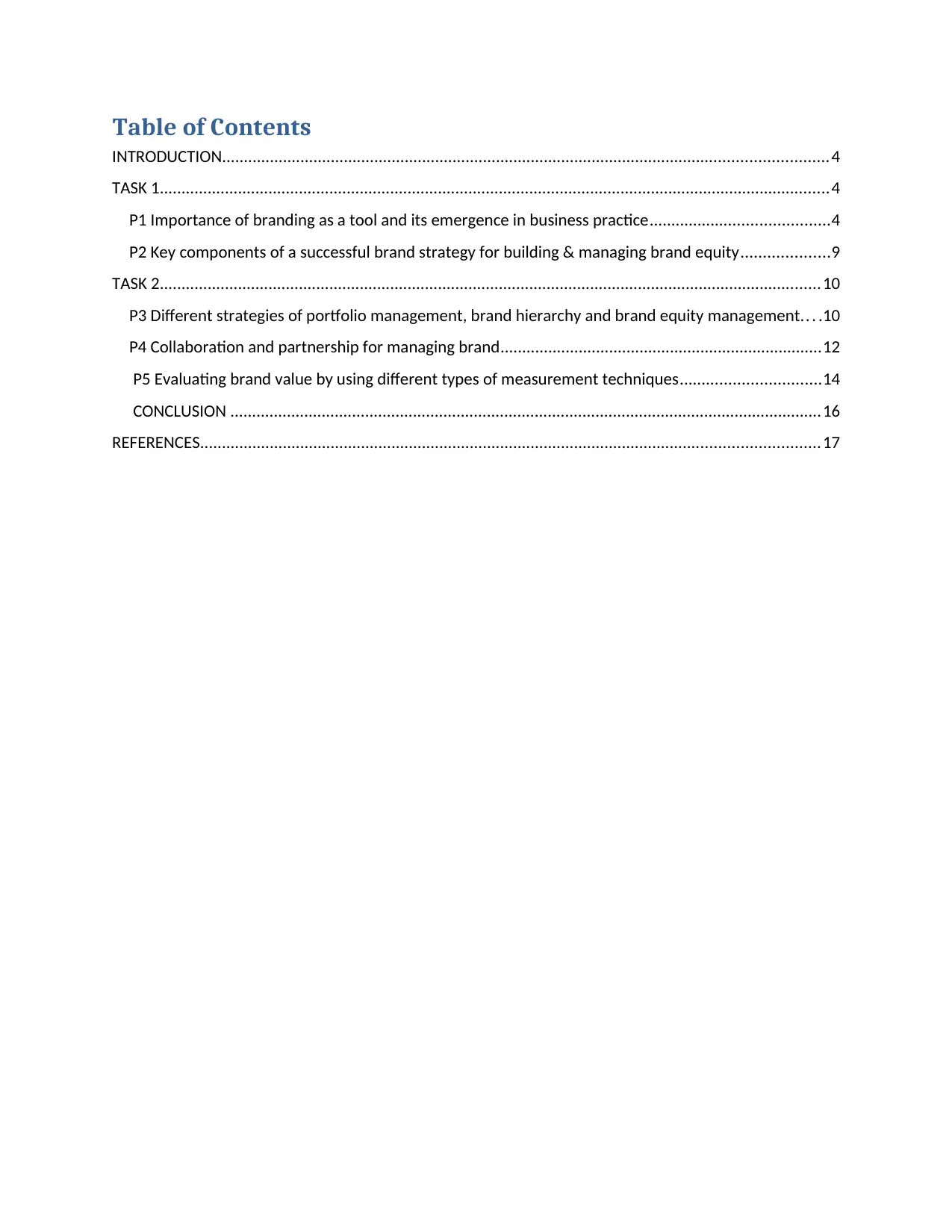
Table of Contents
INTRODUCTION...........................................................................................................................................4
TASK 1..........................................................................................................................................................4
P1 Importance of branding as a tool and its emergence in business practice.........................................4
P2 Key components of a successful brand strategy for building & managing brand equity....................9
TASK 2........................................................................................................................................................10
P3 Different strategies of portfolio management, brand hierarchy and brand equity management.. . .10
P4 Collaboration and partnership for managing brand..........................................................................12
P5 Evaluating brand value by using different types of measurement techniques................................14
CONCLUSION ........................................................................................................................................16
REFERENCES..............................................................................................................................................17
INTRODUCTION...........................................................................................................................................4
TASK 1..........................................................................................................................................................4
P1 Importance of branding as a tool and its emergence in business practice.........................................4
P2 Key components of a successful brand strategy for building & managing brand equity....................9
TASK 2........................................................................................................................................................10
P3 Different strategies of portfolio management, brand hierarchy and brand equity management.. . .10
P4 Collaboration and partnership for managing brand..........................................................................12
P5 Evaluating brand value by using different types of measurement techniques................................14
CONCLUSION ........................................................................................................................................16
REFERENCES..............................................................................................................................................17
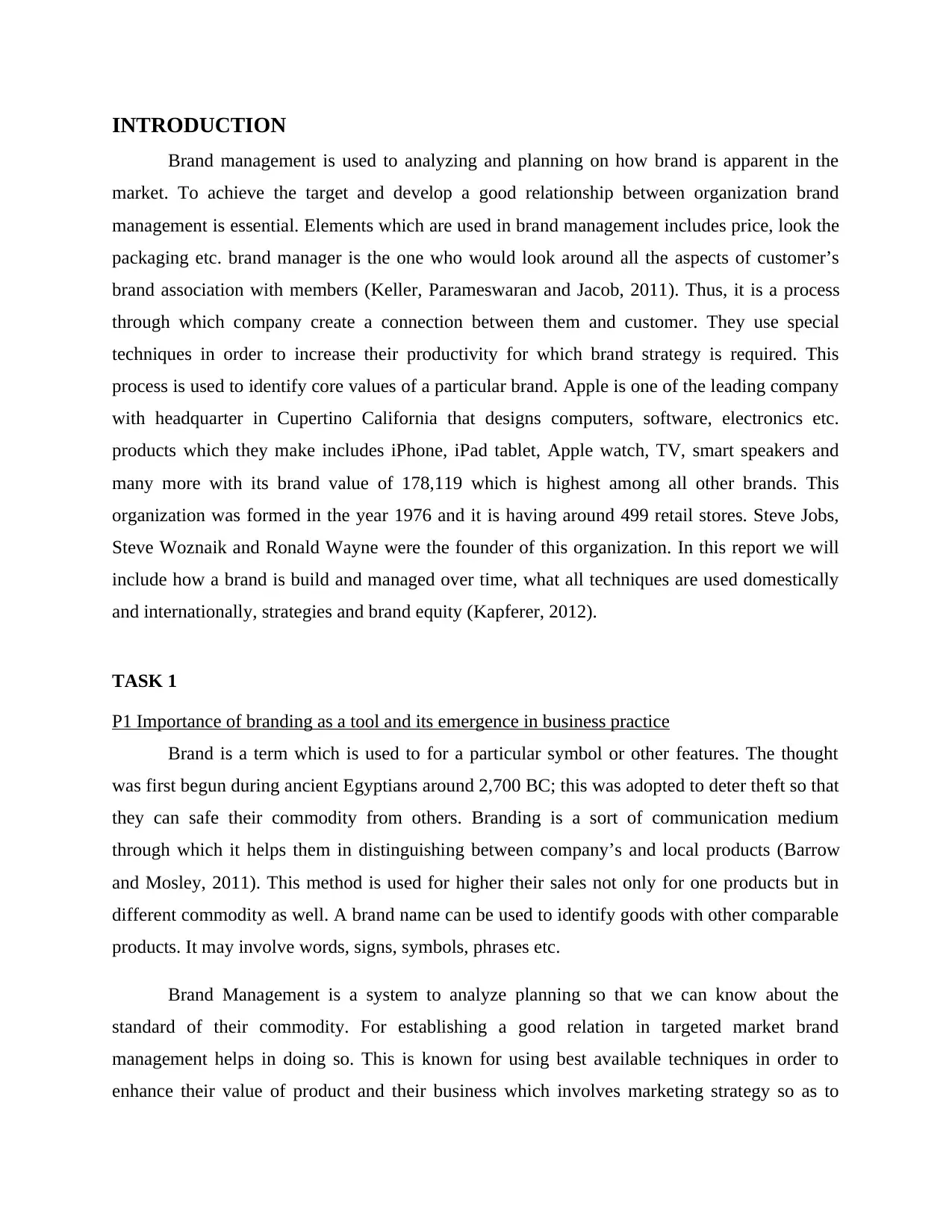
INTRODUCTION
Brand management is used to analyzing and planning on how brand is apparent in the
market. To achieve the target and develop a good relationship between organization brand
management is essential. Elements which are used in brand management includes price, look the
packaging etc. brand manager is the one who would look around all the aspects of customer’s
brand association with members (Keller, Parameswaran and Jacob, 2011). Thus, it is a process
through which company create a connection between them and customer. They use special
techniques in order to increase their productivity for which brand strategy is required. This
process is used to identify core values of a particular brand. Apple is one of the leading company
with headquarter in Cupertino California that designs computers, software, electronics etc.
products which they make includes iPhone, iPad tablet, Apple watch, TV, smart speakers and
many more with its brand value of 178,119 which is highest among all other brands. This
organization was formed in the year 1976 and it is having around 499 retail stores. Steve Jobs,
Steve Woznaik and Ronald Wayne were the founder of this organization. In this report we will
include how a brand is build and managed over time, what all techniques are used domestically
and internationally, strategies and brand equity (Kapferer, 2012).
TASK 1
P1 Importance of branding as a tool and its emergence in business practice
Brand is a term which is used to for a particular symbol or other features. The thought
was first begun during ancient Egyptians around 2,700 BC; this was adopted to deter theft so that
they can safe their commodity from others. Branding is a sort of communication medium
through which it helps them in distinguishing between company’s and local products (Barrow
and Mosley, 2011). This method is used for higher their sales not only for one products but in
different commodity as well. A brand name can be used to identify goods with other comparable
products. It may involve words, signs, symbols, phrases etc.
Brand Management is a system to analyze planning so that we can know about the
standard of their commodity. For establishing a good relation in targeted market brand
management helps in doing so. This is known for using best available techniques in order to
enhance their value of product and their business which involves marketing strategy so as to
Brand management is used to analyzing and planning on how brand is apparent in the
market. To achieve the target and develop a good relationship between organization brand
management is essential. Elements which are used in brand management includes price, look the
packaging etc. brand manager is the one who would look around all the aspects of customer’s
brand association with members (Keller, Parameswaran and Jacob, 2011). Thus, it is a process
through which company create a connection between them and customer. They use special
techniques in order to increase their productivity for which brand strategy is required. This
process is used to identify core values of a particular brand. Apple is one of the leading company
with headquarter in Cupertino California that designs computers, software, electronics etc.
products which they make includes iPhone, iPad tablet, Apple watch, TV, smart speakers and
many more with its brand value of 178,119 which is highest among all other brands. This
organization was formed in the year 1976 and it is having around 499 retail stores. Steve Jobs,
Steve Woznaik and Ronald Wayne were the founder of this organization. In this report we will
include how a brand is build and managed over time, what all techniques are used domestically
and internationally, strategies and brand equity (Kapferer, 2012).
TASK 1
P1 Importance of branding as a tool and its emergence in business practice
Brand is a term which is used to for a particular symbol or other features. The thought
was first begun during ancient Egyptians around 2,700 BC; this was adopted to deter theft so that
they can safe their commodity from others. Branding is a sort of communication medium
through which it helps them in distinguishing between company’s and local products (Barrow
and Mosley, 2011). This method is used for higher their sales not only for one products but in
different commodity as well. A brand name can be used to identify goods with other comparable
products. It may involve words, signs, symbols, phrases etc.
Brand Management is a system to analyze planning so that we can know about the
standard of their commodity. For establishing a good relation in targeted market brand
management helps in doing so. This is known for using best available techniques in order to
enhance their value of product and their business which involves marketing strategy so as to
⊘ This is a preview!⊘
Do you want full access?
Subscribe today to unlock all pages.

Trusted by 1+ million students worldwide
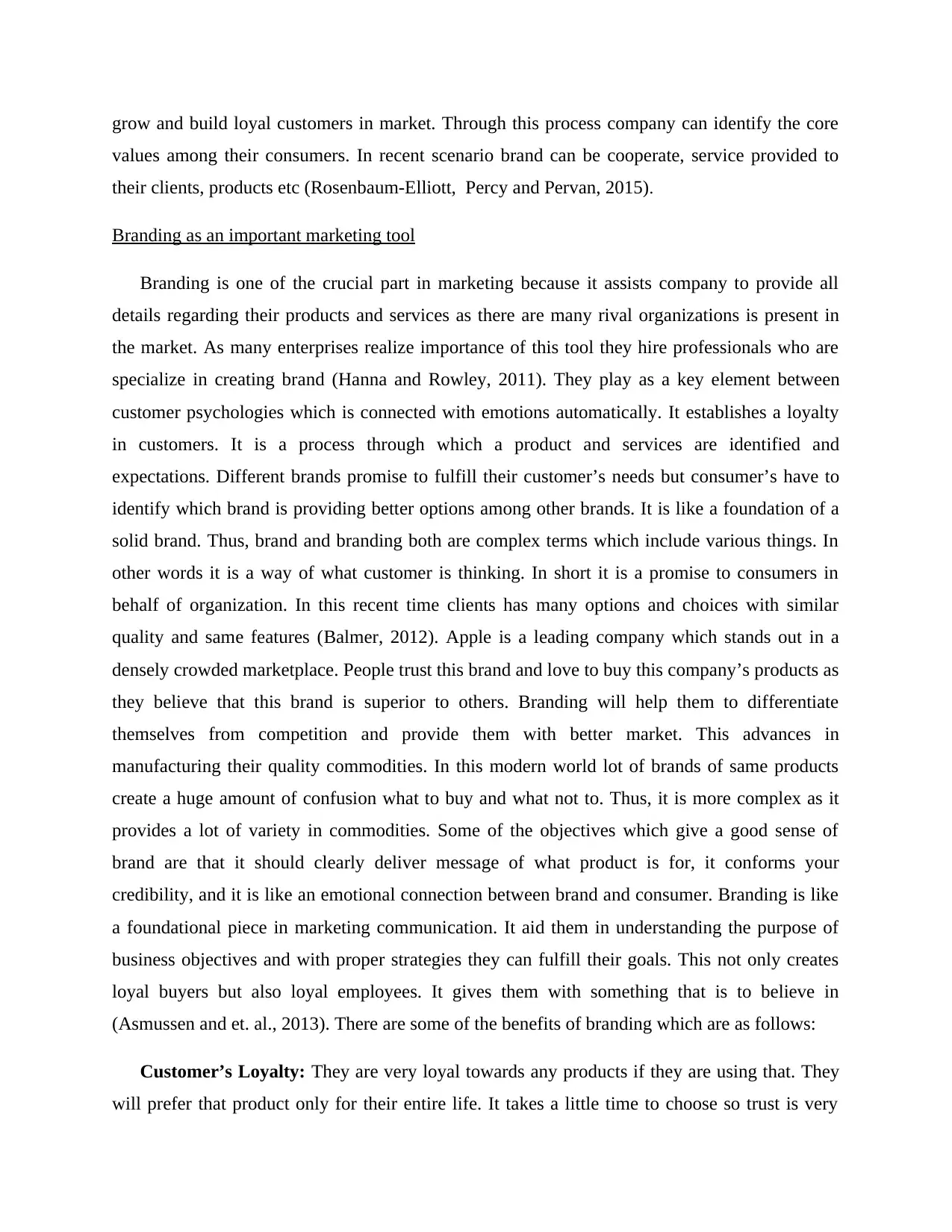
grow and build loyal customers in market. Through this process company can identify the core
values among their consumers. In recent scenario brand can be cooperate, service provided to
their clients, products etc (Rosenbaum-Elliott, Percy and Pervan, 2015).
Branding as an important marketing tool
Branding is one of the crucial part in marketing because it assists company to provide all
details regarding their products and services as there are many rival organizations is present in
the market. As many enterprises realize importance of this tool they hire professionals who are
specialize in creating brand (Hanna and Rowley, 2011). They play as a key element between
customer psychologies which is connected with emotions automatically. It establishes a loyalty
in customers. It is a process through which a product and services are identified and
expectations. Different brands promise to fulfill their customer’s needs but consumer’s have to
identify which brand is providing better options among other brands. It is like a foundation of a
solid brand. Thus, brand and branding both are complex terms which include various things. In
other words it is a way of what customer is thinking. In short it is a promise to consumers in
behalf of organization. In this recent time clients has many options and choices with similar
quality and same features (Balmer, 2012). Apple is a leading company which stands out in a
densely crowded marketplace. People trust this brand and love to buy this company’s products as
they believe that this brand is superior to others. Branding will help them to differentiate
themselves from competition and provide them with better market. This advances in
manufacturing their quality commodities. In this modern world lot of brands of same products
create a huge amount of confusion what to buy and what not to. Thus, it is more complex as it
provides a lot of variety in commodities. Some of the objectives which give a good sense of
brand are that it should clearly deliver message of what product is for, it conforms your
credibility, and it is like an emotional connection between brand and consumer. Branding is like
a foundational piece in marketing communication. It aid them in understanding the purpose of
business objectives and with proper strategies they can fulfill their goals. This not only creates
loyal buyers but also loyal employees. It gives them with something that is to believe in
(Asmussen and et. al., 2013). There are some of the benefits of branding which are as follows:
Customer’s Loyalty: They are very loyal towards any products if they are using that. They
will prefer that product only for their entire life. It takes a little time to choose so trust is very
values among their consumers. In recent scenario brand can be cooperate, service provided to
their clients, products etc (Rosenbaum-Elliott, Percy and Pervan, 2015).
Branding as an important marketing tool
Branding is one of the crucial part in marketing because it assists company to provide all
details regarding their products and services as there are many rival organizations is present in
the market. As many enterprises realize importance of this tool they hire professionals who are
specialize in creating brand (Hanna and Rowley, 2011). They play as a key element between
customer psychologies which is connected with emotions automatically. It establishes a loyalty
in customers. It is a process through which a product and services are identified and
expectations. Different brands promise to fulfill their customer’s needs but consumer’s have to
identify which brand is providing better options among other brands. It is like a foundation of a
solid brand. Thus, brand and branding both are complex terms which include various things. In
other words it is a way of what customer is thinking. In short it is a promise to consumers in
behalf of organization. In this recent time clients has many options and choices with similar
quality and same features (Balmer, 2012). Apple is a leading company which stands out in a
densely crowded marketplace. People trust this brand and love to buy this company’s products as
they believe that this brand is superior to others. Branding will help them to differentiate
themselves from competition and provide them with better market. This advances in
manufacturing their quality commodities. In this modern world lot of brands of same products
create a huge amount of confusion what to buy and what not to. Thus, it is more complex as it
provides a lot of variety in commodities. Some of the objectives which give a good sense of
brand are that it should clearly deliver message of what product is for, it conforms your
credibility, and it is like an emotional connection between brand and consumer. Branding is like
a foundational piece in marketing communication. It aid them in understanding the purpose of
business objectives and with proper strategies they can fulfill their goals. This not only creates
loyal buyers but also loyal employees. It gives them with something that is to believe in
(Asmussen and et. al., 2013). There are some of the benefits of branding which are as follows:
Customer’s Loyalty: They are very loyal towards any products if they are using that. They
will prefer that product only for their entire life. It takes a little time to choose so trust is very
Paraphrase This Document
Need a fresh take? Get an instant paraphrase of this document with our AI Paraphraser
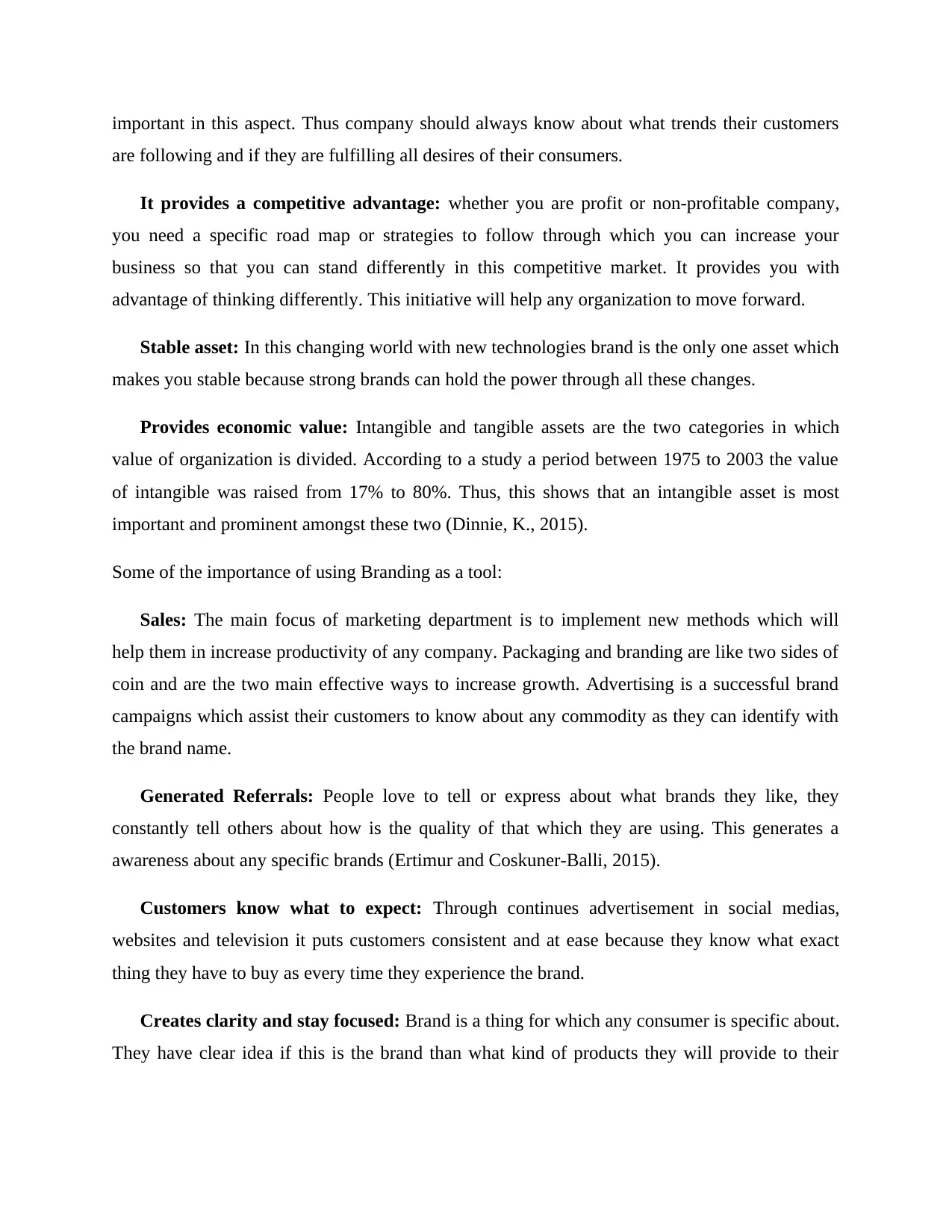
important in this aspect. Thus company should always know about what trends their customers
are following and if they are fulfilling all desires of their consumers.
It provides a competitive advantage: whether you are profit or non-profitable company,
you need a specific road map or strategies to follow through which you can increase your
business so that you can stand differently in this competitive market. It provides you with
advantage of thinking differently. This initiative will help any organization to move forward.
Stable asset: In this changing world with new technologies brand is the only one asset which
makes you stable because strong brands can hold the power through all these changes.
Provides economic value: Intangible and tangible assets are the two categories in which
value of organization is divided. According to a study a period between 1975 to 2003 the value
of intangible was raised from 17% to 80%. Thus, this shows that an intangible asset is most
important and prominent amongst these two (Dinnie, K., 2015).
Some of the importance of using Branding as a tool:
Sales: The main focus of marketing department is to implement new methods which will
help them in increase productivity of any company. Packaging and branding are like two sides of
coin and are the two main effective ways to increase growth. Advertising is a successful brand
campaigns which assist their customers to know about any commodity as they can identify with
the brand name.
Generated Referrals: People love to tell or express about what brands they like, they
constantly tell others about how is the quality of that which they are using. This generates a
awareness about any specific brands (Ertimur and Coskuner-Balli, 2015).
Customers know what to expect: Through continues advertisement in social medias,
websites and television it puts customers consistent and at ease because they know what exact
thing they have to buy as every time they experience the brand.
Creates clarity and stay focused: Brand is a thing for which any consumer is specific about.
They have clear idea if this is the brand than what kind of products they will provide to their
are following and if they are fulfilling all desires of their consumers.
It provides a competitive advantage: whether you are profit or non-profitable company,
you need a specific road map or strategies to follow through which you can increase your
business so that you can stand differently in this competitive market. It provides you with
advantage of thinking differently. This initiative will help any organization to move forward.
Stable asset: In this changing world with new technologies brand is the only one asset which
makes you stable because strong brands can hold the power through all these changes.
Provides economic value: Intangible and tangible assets are the two categories in which
value of organization is divided. According to a study a period between 1975 to 2003 the value
of intangible was raised from 17% to 80%. Thus, this shows that an intangible asset is most
important and prominent amongst these two (Dinnie, K., 2015).
Some of the importance of using Branding as a tool:
Sales: The main focus of marketing department is to implement new methods which will
help them in increase productivity of any company. Packaging and branding are like two sides of
coin and are the two main effective ways to increase growth. Advertising is a successful brand
campaigns which assist their customers to know about any commodity as they can identify with
the brand name.
Generated Referrals: People love to tell or express about what brands they like, they
constantly tell others about how is the quality of that which they are using. This generates a
awareness about any specific brands (Ertimur and Coskuner-Balli, 2015).
Customers know what to expect: Through continues advertisement in social medias,
websites and television it puts customers consistent and at ease because they know what exact
thing they have to buy as every time they experience the brand.
Creates clarity and stay focused: Brand is a thing for which any consumer is specific about.
They have clear idea if this is the brand than what kind of products they will provide to their
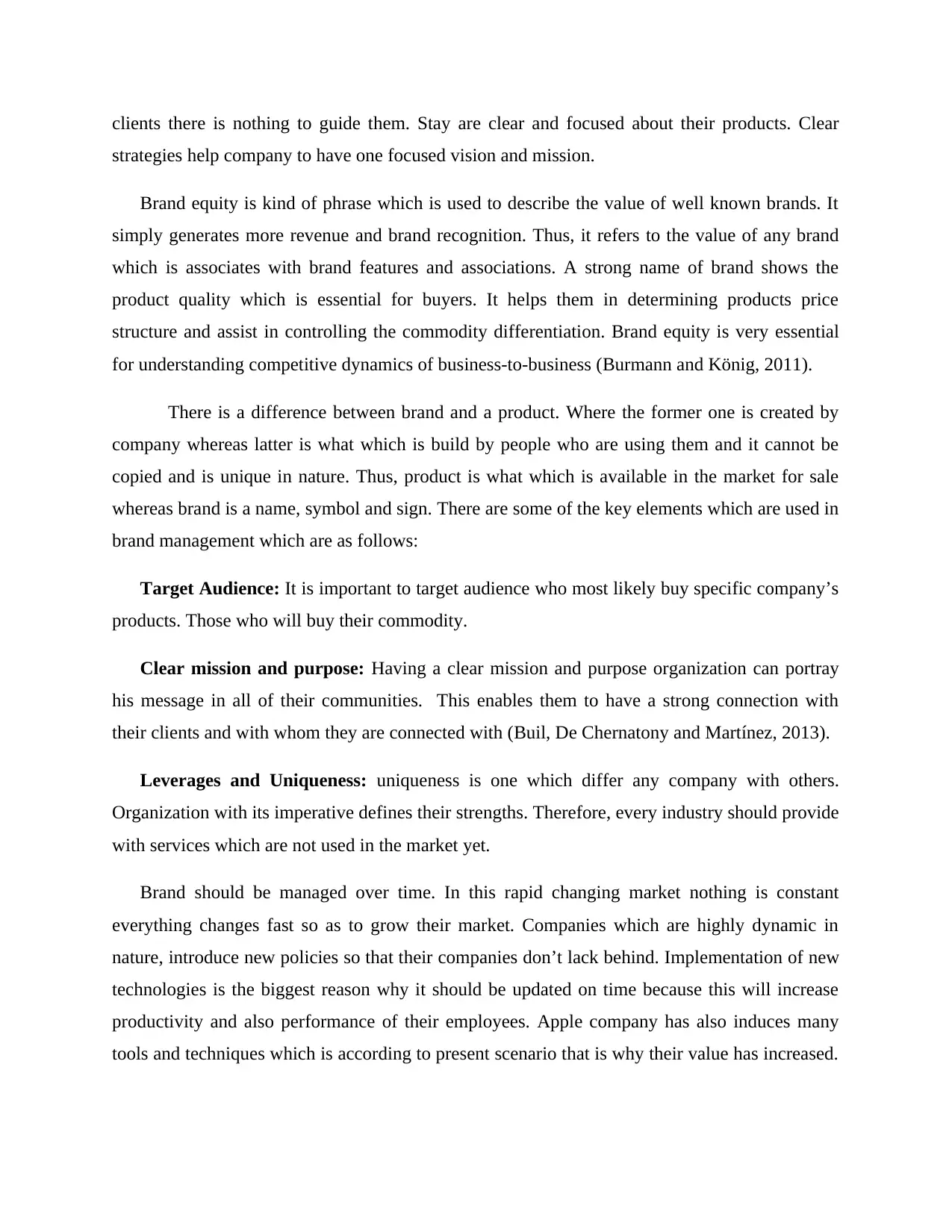
clients there is nothing to guide them. Stay are clear and focused about their products. Clear
strategies help company to have one focused vision and mission.
Brand equity is kind of phrase which is used to describe the value of well known brands. It
simply generates more revenue and brand recognition. Thus, it refers to the value of any brand
which is associates with brand features and associations. A strong name of brand shows the
product quality which is essential for buyers. It helps them in determining products price
structure and assist in controlling the commodity differentiation. Brand equity is very essential
for understanding competitive dynamics of business-to-business (Burmann and König, 2011).
There is a difference between brand and a product. Where the former one is created by
company whereas latter is what which is build by people who are using them and it cannot be
copied and is unique in nature. Thus, product is what which is available in the market for sale
whereas brand is a name, symbol and sign. There are some of the key elements which are used in
brand management which are as follows:
Target Audience: It is important to target audience who most likely buy specific company’s
products. Those who will buy their commodity.
Clear mission and purpose: Having a clear mission and purpose organization can portray
his message in all of their communities. This enables them to have a strong connection with
their clients and with whom they are connected with (Buil, De Chernatony and Martínez, 2013).
Leverages and Uniqueness: uniqueness is one which differ any company with others.
Organization with its imperative defines their strengths. Therefore, every industry should provide
with services which are not used in the market yet.
Brand should be managed over time. In this rapid changing market nothing is constant
everything changes fast so as to grow their market. Companies which are highly dynamic in
nature, introduce new policies so that their companies don’t lack behind. Implementation of new
technologies is the biggest reason why it should be updated on time because this will increase
productivity and also performance of their employees. Apple company has also induces many
tools and techniques which is according to present scenario that is why their value has increased.
strategies help company to have one focused vision and mission.
Brand equity is kind of phrase which is used to describe the value of well known brands. It
simply generates more revenue and brand recognition. Thus, it refers to the value of any brand
which is associates with brand features and associations. A strong name of brand shows the
product quality which is essential for buyers. It helps them in determining products price
structure and assist in controlling the commodity differentiation. Brand equity is very essential
for understanding competitive dynamics of business-to-business (Burmann and König, 2011).
There is a difference between brand and a product. Where the former one is created by
company whereas latter is what which is build by people who are using them and it cannot be
copied and is unique in nature. Thus, product is what which is available in the market for sale
whereas brand is a name, symbol and sign. There are some of the key elements which are used in
brand management which are as follows:
Target Audience: It is important to target audience who most likely buy specific company’s
products. Those who will buy their commodity.
Clear mission and purpose: Having a clear mission and purpose organization can portray
his message in all of their communities. This enables them to have a strong connection with
their clients and with whom they are connected with (Buil, De Chernatony and Martínez, 2013).
Leverages and Uniqueness: uniqueness is one which differ any company with others.
Organization with its imperative defines their strengths. Therefore, every industry should provide
with services which are not used in the market yet.
Brand should be managed over time. In this rapid changing market nothing is constant
everything changes fast so as to grow their market. Companies which are highly dynamic in
nature, introduce new policies so that their companies don’t lack behind. Implementation of new
technologies is the biggest reason why it should be updated on time because this will increase
productivity and also performance of their employees. Apple company has also induces many
tools and techniques which is according to present scenario that is why their value has increased.
⊘ This is a preview!⊘
Do you want full access?
Subscribe today to unlock all pages.

Trusted by 1+ million students worldwide
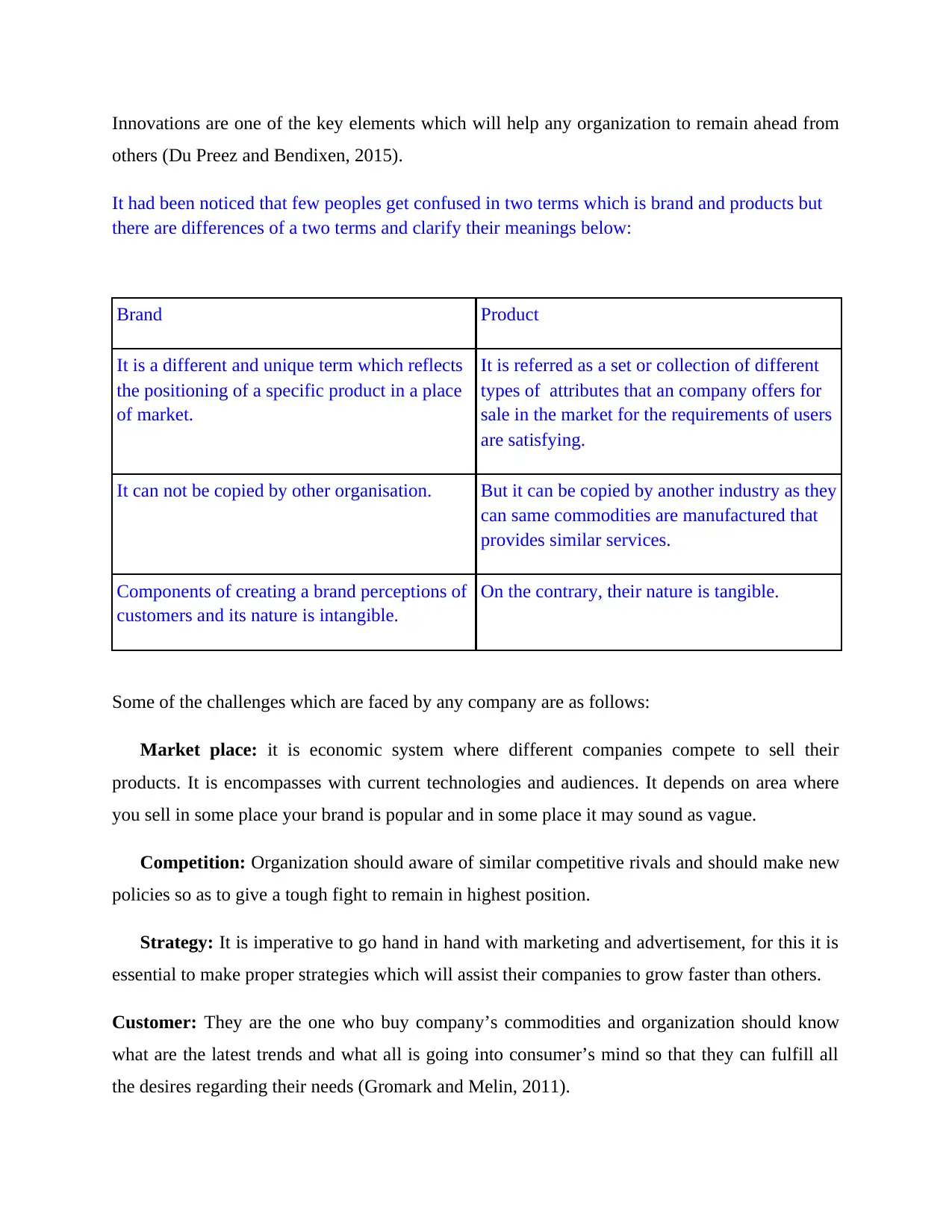
Innovations are one of the key elements which will help any organization to remain ahead from
others (Du Preez and Bendixen, 2015).
It had been noticed that few peoples get confused in two terms which is brand and products but
there are differences of a two terms and clarify their meanings below:
Brand Product
It is a different and unique term which reflects
the positioning of a specific product in a place
of market.
It is referred as a set or collection of different
types of attributes that an company offers for
sale in the market for the requirements of users
are satisfying.
It can not be copied by other organisation. But it can be copied by another industry as they
can same commodities are manufactured that
provides similar services.
Components of creating a brand perceptions of
customers and its nature is intangible.
On the contrary, their nature is tangible.
Some of the challenges which are faced by any company are as follows:
Market place: it is economic system where different companies compete to sell their
products. It is encompasses with current technologies and audiences. It depends on area where
you sell in some place your brand is popular and in some place it may sound as vague.
Competition: Organization should aware of similar competitive rivals and should make new
policies so as to give a tough fight to remain in highest position.
Strategy: It is imperative to go hand in hand with marketing and advertisement, for this it is
essential to make proper strategies which will assist their companies to grow faster than others.
Customer: They are the one who buy company’s commodities and organization should know
what are the latest trends and what all is going into consumer’s mind so that they can fulfill all
the desires regarding their needs (Gromark and Melin, 2011).
others (Du Preez and Bendixen, 2015).
It had been noticed that few peoples get confused in two terms which is brand and products but
there are differences of a two terms and clarify their meanings below:
Brand Product
It is a different and unique term which reflects
the positioning of a specific product in a place
of market.
It is referred as a set or collection of different
types of attributes that an company offers for
sale in the market for the requirements of users
are satisfying.
It can not be copied by other organisation. But it can be copied by another industry as they
can same commodities are manufactured that
provides similar services.
Components of creating a brand perceptions of
customers and its nature is intangible.
On the contrary, their nature is tangible.
Some of the challenges which are faced by any company are as follows:
Market place: it is economic system where different companies compete to sell their
products. It is encompasses with current technologies and audiences. It depends on area where
you sell in some place your brand is popular and in some place it may sound as vague.
Competition: Organization should aware of similar competitive rivals and should make new
policies so as to give a tough fight to remain in highest position.
Strategy: It is imperative to go hand in hand with marketing and advertisement, for this it is
essential to make proper strategies which will assist their companies to grow faster than others.
Customer: They are the one who buy company’s commodities and organization should know
what are the latest trends and what all is going into consumer’s mind so that they can fulfill all
the desires regarding their needs (Gromark and Melin, 2011).
Paraphrase This Document
Need a fresh take? Get an instant paraphrase of this document with our AI Paraphraser
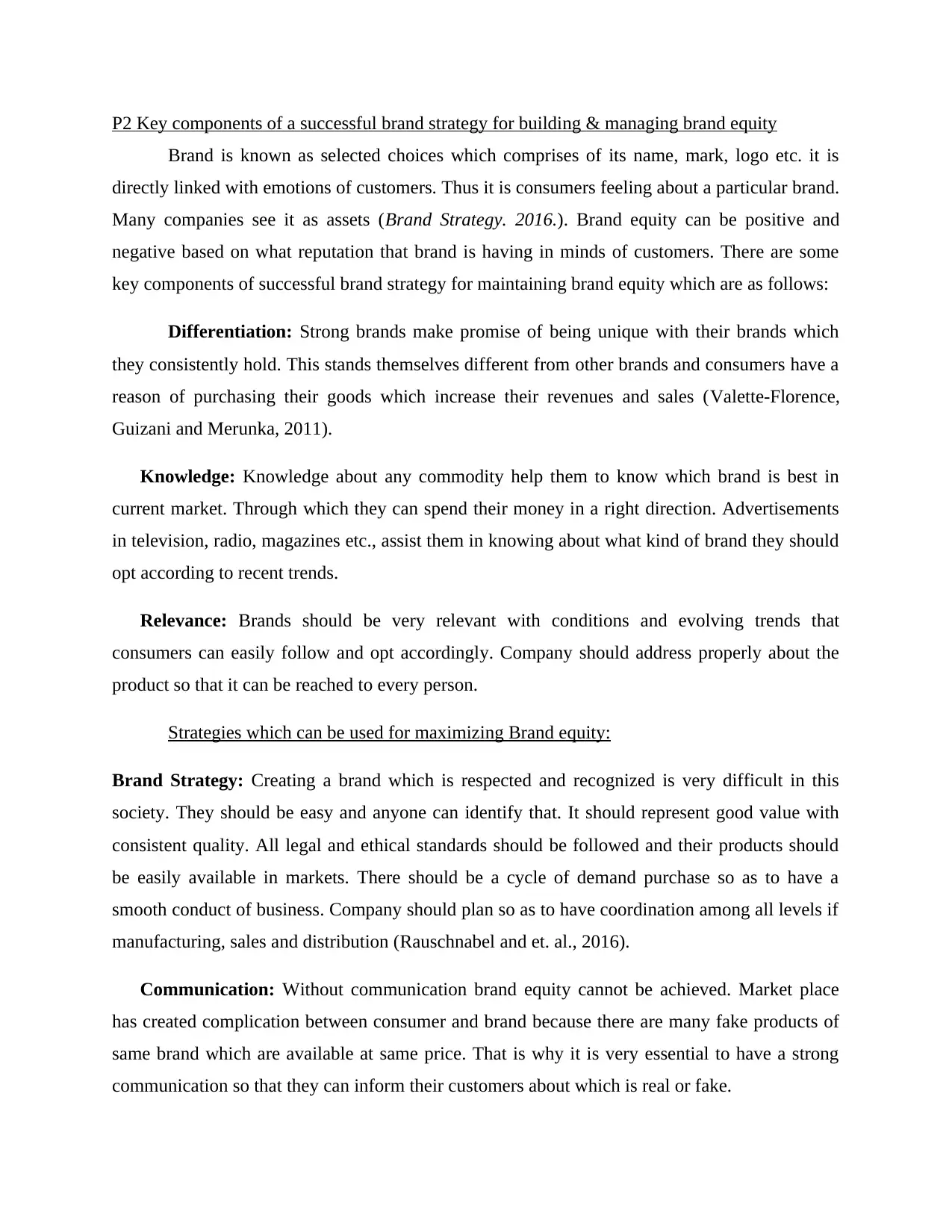
P2 Key components of a successful brand strategy for building & managing brand equity
Brand is known as selected choices which comprises of its name, mark, logo etc. it is
directly linked with emotions of customers. Thus it is consumers feeling about a particular brand.
Many companies see it as assets (Brand Strategy. 2016.). Brand equity can be positive and
negative based on what reputation that brand is having in minds of customers. There are some
key components of successful brand strategy for maintaining brand equity which are as follows:
Differentiation: Strong brands make promise of being unique with their brands which
they consistently hold. This stands themselves different from other brands and consumers have a
reason of purchasing their goods which increase their revenues and sales (Valette-Florence,
Guizani and Merunka, 2011).
Knowledge: Knowledge about any commodity help them to know which brand is best in
current market. Through which they can spend their money in a right direction. Advertisements
in television, radio, magazines etc., assist them in knowing about what kind of brand they should
opt according to recent trends.
Relevance: Brands should be very relevant with conditions and evolving trends that
consumers can easily follow and opt accordingly. Company should address properly about the
product so that it can be reached to every person.
Strategies which can be used for maximizing Brand equity:
Brand Strategy: Creating a brand which is respected and recognized is very difficult in this
society. They should be easy and anyone can identify that. It should represent good value with
consistent quality. All legal and ethical standards should be followed and their products should
be easily available in markets. There should be a cycle of demand purchase so as to have a
smooth conduct of business. Company should plan so as to have coordination among all levels if
manufacturing, sales and distribution (Rauschnabel and et. al., 2016).
Communication: Without communication brand equity cannot be achieved. Market place
has created complication between consumer and brand because there are many fake products of
same brand which are available at same price. That is why it is very essential to have a strong
communication so that they can inform their customers about which is real or fake.
Brand is known as selected choices which comprises of its name, mark, logo etc. it is
directly linked with emotions of customers. Thus it is consumers feeling about a particular brand.
Many companies see it as assets (Brand Strategy. 2016.). Brand equity can be positive and
negative based on what reputation that brand is having in minds of customers. There are some
key components of successful brand strategy for maintaining brand equity which are as follows:
Differentiation: Strong brands make promise of being unique with their brands which
they consistently hold. This stands themselves different from other brands and consumers have a
reason of purchasing their goods which increase their revenues and sales (Valette-Florence,
Guizani and Merunka, 2011).
Knowledge: Knowledge about any commodity help them to know which brand is best in
current market. Through which they can spend their money in a right direction. Advertisements
in television, radio, magazines etc., assist them in knowing about what kind of brand they should
opt according to recent trends.
Relevance: Brands should be very relevant with conditions and evolving trends that
consumers can easily follow and opt accordingly. Company should address properly about the
product so that it can be reached to every person.
Strategies which can be used for maximizing Brand equity:
Brand Strategy: Creating a brand which is respected and recognized is very difficult in this
society. They should be easy and anyone can identify that. It should represent good value with
consistent quality. All legal and ethical standards should be followed and their products should
be easily available in markets. There should be a cycle of demand purchase so as to have a
smooth conduct of business. Company should plan so as to have coordination among all levels if
manufacturing, sales and distribution (Rauschnabel and et. al., 2016).
Communication: Without communication brand equity cannot be achieved. Market place
has created complication between consumer and brand because there are many fake products of
same brand which are available at same price. That is why it is very essential to have a strong
communication so that they can inform their customers about which is real or fake.
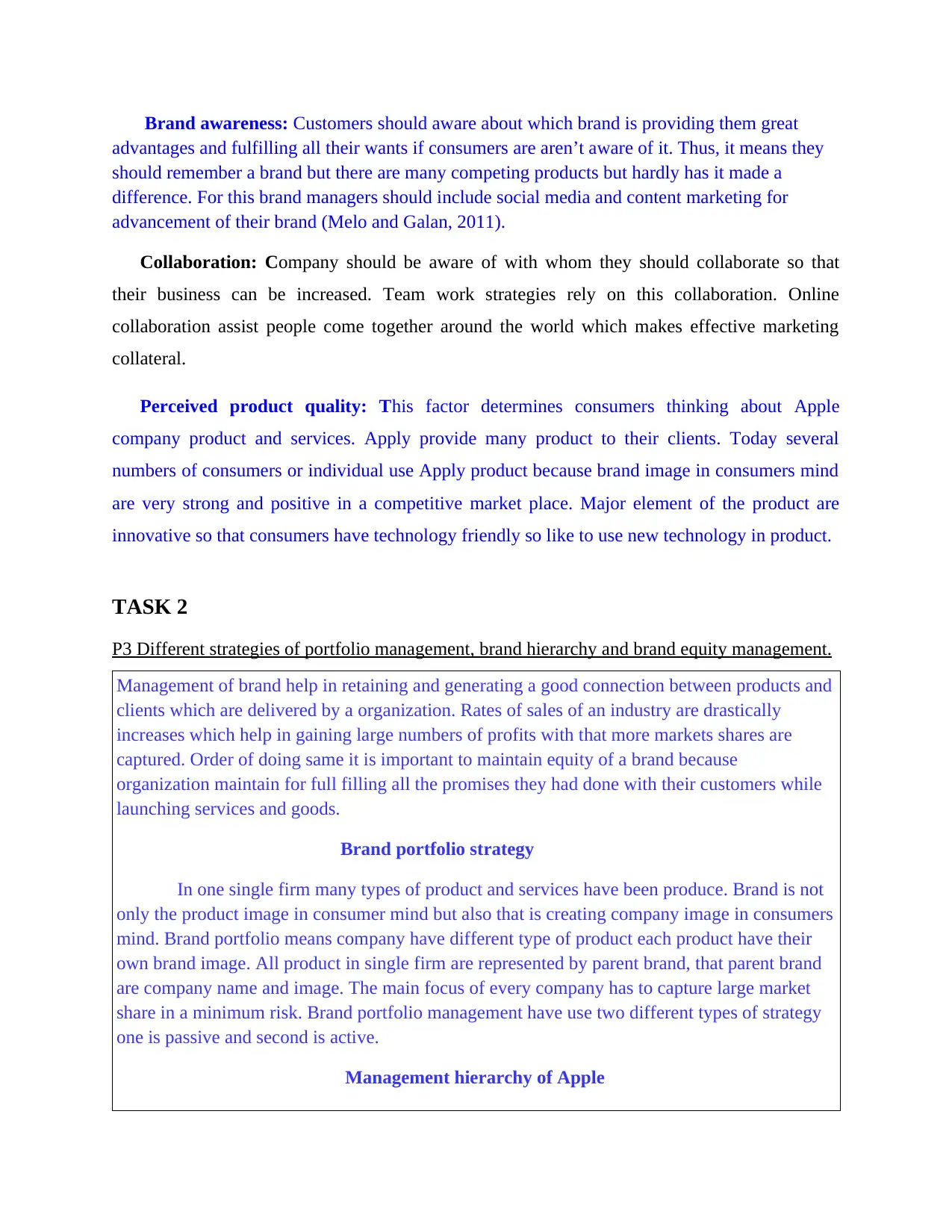
Brand awareness: Customers should aware about which brand is providing them great
advantages and fulfilling all their wants if consumers are aren’t aware of it. Thus, it means they
should remember a brand but there are many competing products but hardly has it made a
difference. For this brand managers should include social media and content marketing for
advancement of their brand (Melo and Galan, 2011).
Collaboration: Company should be aware of with whom they should collaborate so that
their business can be increased. Team work strategies rely on this collaboration. Online
collaboration assist people come together around the world which makes effective marketing
collateral.
Perceived product quality: This factor determines consumers thinking about Apple
company product and services. Apply provide many product to their clients. Today several
numbers of consumers or individual use Apply product because brand image in consumers mind
are very strong and positive in a competitive market place. Major element of the product are
innovative so that consumers have technology friendly so like to use new technology in product.
TASK 2
P3 Different strategies of portfolio management, brand hierarchy and brand equity management.
Management of brand help in retaining and generating a good connection between products and
clients which are delivered by a organization. Rates of sales of an industry are drastically
increases which help in gaining large numbers of profits with that more markets shares are
captured. Order of doing same it is important to maintain equity of a brand because
organization maintain for full filling all the promises they had done with their customers while
launching services and goods.
Brand portfolio strategy
In one single firm many types of product and services have been produce. Brand is not
only the product image in consumer mind but also that is creating company image in consumers
mind. Brand portfolio means company have different type of product each product have their
own brand image. All product in single firm are represented by parent brand, that parent brand
are company name and image. The main focus of every company has to capture large market
share in a minimum risk. Brand portfolio management have use two different types of strategy
one is passive and second is active.
Management hierarchy of Apple
advantages and fulfilling all their wants if consumers are aren’t aware of it. Thus, it means they
should remember a brand but there are many competing products but hardly has it made a
difference. For this brand managers should include social media and content marketing for
advancement of their brand (Melo and Galan, 2011).
Collaboration: Company should be aware of with whom they should collaborate so that
their business can be increased. Team work strategies rely on this collaboration. Online
collaboration assist people come together around the world which makes effective marketing
collateral.
Perceived product quality: This factor determines consumers thinking about Apple
company product and services. Apply provide many product to their clients. Today several
numbers of consumers or individual use Apply product because brand image in consumers mind
are very strong and positive in a competitive market place. Major element of the product are
innovative so that consumers have technology friendly so like to use new technology in product.
TASK 2
P3 Different strategies of portfolio management, brand hierarchy and brand equity management.
Management of brand help in retaining and generating a good connection between products and
clients which are delivered by a organization. Rates of sales of an industry are drastically
increases which help in gaining large numbers of profits with that more markets shares are
captured. Order of doing same it is important to maintain equity of a brand because
organization maintain for full filling all the promises they had done with their customers while
launching services and goods.
Brand portfolio strategy
In one single firm many types of product and services have been produce. Brand is not
only the product image in consumer mind but also that is creating company image in consumers
mind. Brand portfolio means company have different type of product each product have their
own brand image. All product in single firm are represented by parent brand, that parent brand
are company name and image. The main focus of every company has to capture large market
share in a minimum risk. Brand portfolio management have use two different types of strategy
one is passive and second is active.
Management hierarchy of Apple
⊘ This is a preview!⊘
Do you want full access?
Subscribe today to unlock all pages.

Trusted by 1+ million students worldwide
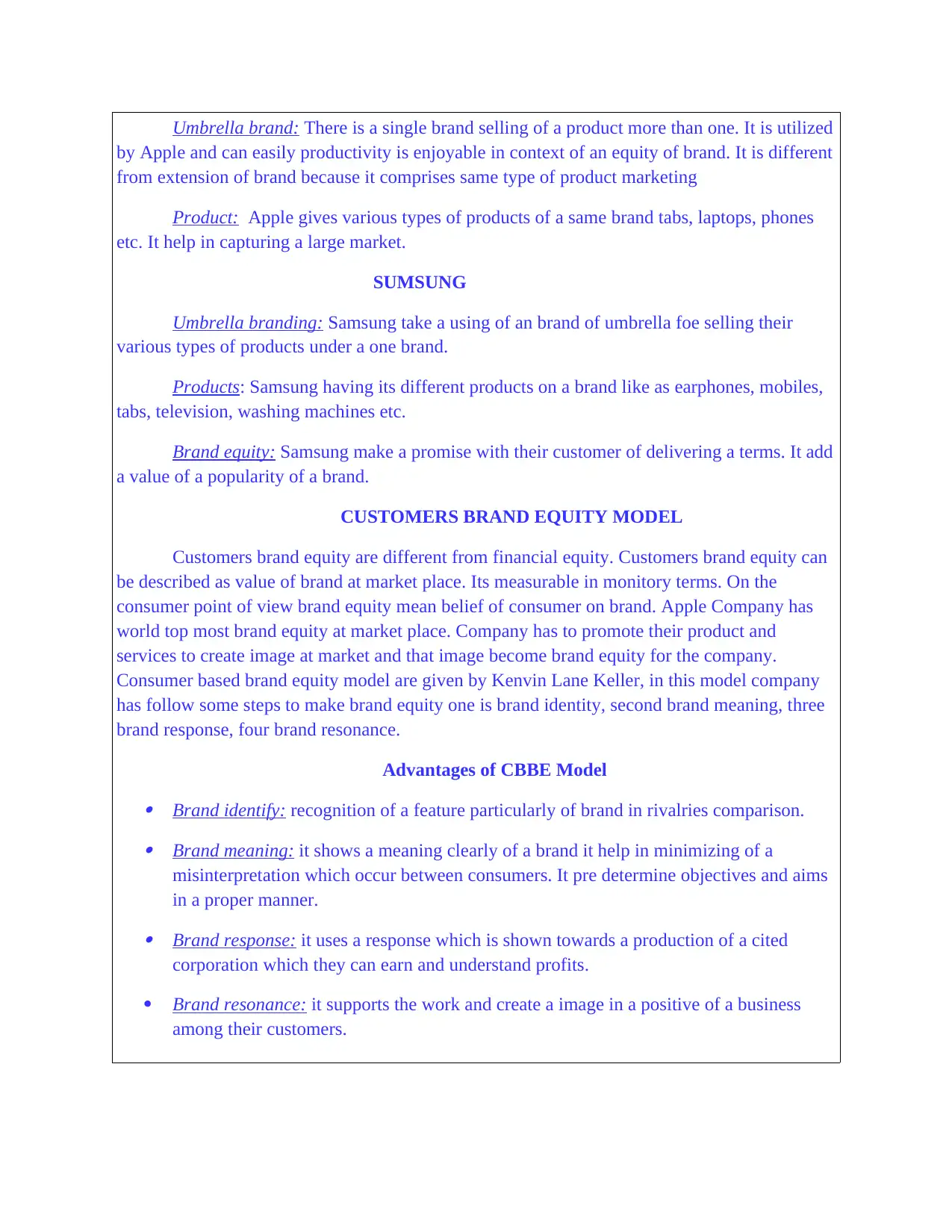
Umbrella brand: There is a single brand selling of a product more than one. It is utilized
by Apple and can easily productivity is enjoyable in context of an equity of brand. It is different
from extension of brand because it comprises same type of product marketing
Product: Apple gives various types of products of a same brand tabs, laptops, phones
etc. It help in capturing a large market.
SUMSUNG
Umbrella branding: Samsung take a using of an brand of umbrella foe selling their
various types of products under a one brand.
Products: Samsung having its different products on a brand like as earphones, mobiles,
tabs, television, washing machines etc.
Brand equity: Samsung make a promise with their customer of delivering a terms. It add
a value of a popularity of a brand.
CUSTOMERS BRAND EQUITY MODEL
Customers brand equity are different from financial equity. Customers brand equity can
be described as value of brand at market place. Its measurable in monitory terms. On the
consumer point of view brand equity mean belief of consumer on brand. Apple Company has
world top most brand equity at market place. Company has to promote their product and
services to create image at market and that image become brand equity for the company.
Consumer based brand equity model are given by Kenvin Lane Keller, in this model company
has follow some steps to make brand equity one is brand identity, second brand meaning, three
brand response, four brand resonance.
Advantages of CBBE Model Brand identify: recognition of a feature particularly of brand in rivalries comparison. Brand meaning: it shows a meaning clearly of a brand it help in minimizing of a
misinterpretation which occur between consumers. It pre determine objectives and aims
in a proper manner. Brand response: it uses a response which is shown towards a production of a cited
corporation which they can earn and understand profits.
Brand resonance: it supports the work and create a image in a positive of a business
among their customers.
by Apple and can easily productivity is enjoyable in context of an equity of brand. It is different
from extension of brand because it comprises same type of product marketing
Product: Apple gives various types of products of a same brand tabs, laptops, phones
etc. It help in capturing a large market.
SUMSUNG
Umbrella branding: Samsung take a using of an brand of umbrella foe selling their
various types of products under a one brand.
Products: Samsung having its different products on a brand like as earphones, mobiles,
tabs, television, washing machines etc.
Brand equity: Samsung make a promise with their customer of delivering a terms. It add
a value of a popularity of a brand.
CUSTOMERS BRAND EQUITY MODEL
Customers brand equity are different from financial equity. Customers brand equity can
be described as value of brand at market place. Its measurable in monitory terms. On the
consumer point of view brand equity mean belief of consumer on brand. Apple Company has
world top most brand equity at market place. Company has to promote their product and
services to create image at market and that image become brand equity for the company.
Consumer based brand equity model are given by Kenvin Lane Keller, in this model company
has follow some steps to make brand equity one is brand identity, second brand meaning, three
brand response, four brand resonance.
Advantages of CBBE Model Brand identify: recognition of a feature particularly of brand in rivalries comparison. Brand meaning: it shows a meaning clearly of a brand it help in minimizing of a
misinterpretation which occur between consumers. It pre determine objectives and aims
in a proper manner. Brand response: it uses a response which is shown towards a production of a cited
corporation which they can earn and understand profits.
Brand resonance: it supports the work and create a image in a positive of a business
among their customers.
Paraphrase This Document
Need a fresh take? Get an instant paraphrase of this document with our AI Paraphraser
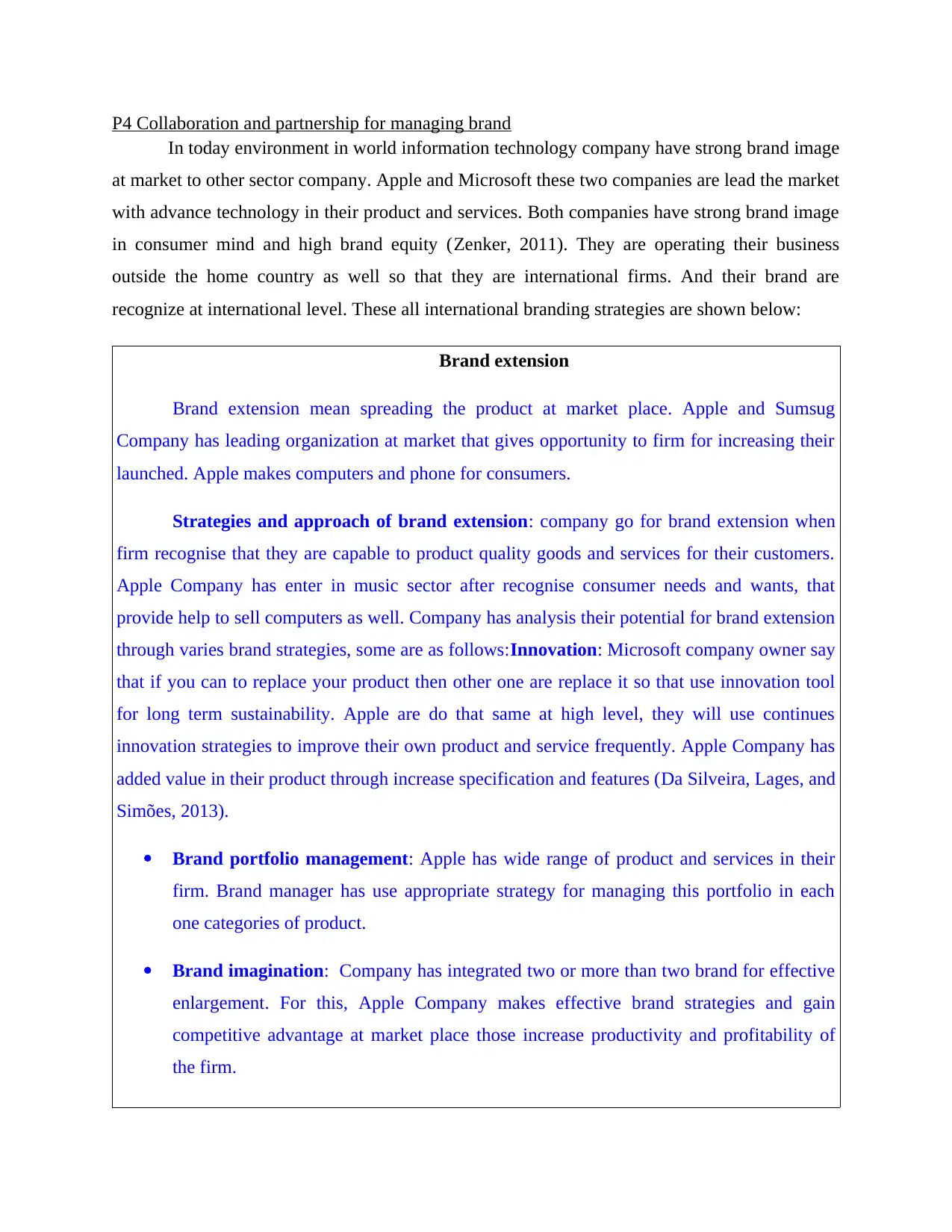
P4 Collaboration and partnership for managing brand
In today environment in world information technology company have strong brand image
at market to other sector company. Apple and Microsoft these two companies are lead the market
with advance technology in their product and services. Both companies have strong brand image
in consumer mind and high brand equity (Zenker, 2011). They are operating their business
outside the home country as well so that they are international firms. And their brand are
recognize at international level. These all international branding strategies are shown below:
Brand extension
Brand extension mean spreading the product at market place. Apple and Sumsug
Company has leading organization at market that gives opportunity to firm for increasing their
launched. Apple makes computers and phone for consumers.
Strategies and approach of brand extension: company go for brand extension when
firm recognise that they are capable to product quality goods and services for their customers.
Apple Company has enter in music sector after recognise consumer needs and wants, that
provide help to sell computers as well. Company has analysis their potential for brand extension
through varies brand strategies, some are as follows:Innovation: Microsoft company owner say
that if you can to replace your product then other one are replace it so that use innovation tool
for long term sustainability. Apple are do that same at high level, they will use continues
innovation strategies to improve their own product and service frequently. Apple Company has
added value in their product through increase specification and features (Da Silveira, Lages, and
Simões, 2013).
Brand portfolio management: Apple has wide range of product and services in their
firm. Brand manager has use appropriate strategy for managing this portfolio in each
one categories of product.
Brand imagination: Company has integrated two or more than two brand for effective
enlargement. For this, Apple Company makes effective brand strategies and gain
competitive advantage at market place those increase productivity and profitability of
the firm.
In today environment in world information technology company have strong brand image
at market to other sector company. Apple and Microsoft these two companies are lead the market
with advance technology in their product and services. Both companies have strong brand image
in consumer mind and high brand equity (Zenker, 2011). They are operating their business
outside the home country as well so that they are international firms. And their brand are
recognize at international level. These all international branding strategies are shown below:
Brand extension
Brand extension mean spreading the product at market place. Apple and Sumsug
Company has leading organization at market that gives opportunity to firm for increasing their
launched. Apple makes computers and phone for consumers.
Strategies and approach of brand extension: company go for brand extension when
firm recognise that they are capable to product quality goods and services for their customers.
Apple Company has enter in music sector after recognise consumer needs and wants, that
provide help to sell computers as well. Company has analysis their potential for brand extension
through varies brand strategies, some are as follows:Innovation: Microsoft company owner say
that if you can to replace your product then other one are replace it so that use innovation tool
for long term sustainability. Apple are do that same at high level, they will use continues
innovation strategies to improve their own product and service frequently. Apple Company has
added value in their product through increase specification and features (Da Silveira, Lages, and
Simões, 2013).
Brand portfolio management: Apple has wide range of product and services in their
firm. Brand manager has use appropriate strategy for managing this portfolio in each
one categories of product.
Brand imagination: Company has integrated two or more than two brand for effective
enlargement. For this, Apple Company makes effective brand strategies and gain
competitive advantage at market place those increase productivity and profitability of
the firm.

Product development: Company has known their market scenario and according to that
they wiil make strategies for future goals. Innovation is very important tool of product
development. Product development is a very risky strategy for the company because
future is uncertain. This strategy can be used by company when they are known their
product is not new for market. Apple Company takes risk and develop new product that
provide first moving advantage to firm at market place. Apple Company has launched
Iphone which are unique for current market (Ruzzier and De Chernatony, 2013).
Market development: Market development means launching their product and services at new
market place for new consumers. Apple company has launch their product and services into
others country as well so that they will develop their market. Through market development
company may increase their profitability and market share because they will encourage new
consumers for purchasing firm product and services. Apple company have operate their
business in several country so that, they have an opportunity to develop new market according
to their culture and environment.
Market penetration: Market penetration mean company has sale their product to existing
consumers of particular goods. In this process consumer demand upgraded version of existing
product and services. Apple company has upgrade their product on continues bases so that they
will attract existing consumer to purchase upgraded version of their product that helps to
increase sells and profitability of the firm. This all process is about generating revenue form
existing consumers by providing better product and services. Through market penetration Apple
company has successful in their consumer retention strategies (Keller, Parameswaran and
Jacob, 2011).
Diversification: Diversification means developing existing product to attract new consumers by
new product and services. Its a risk minimization tool for the brand managers. Its decrease risk
of lees number of consumers, that strategy provide high market share to the firms. Through
diversification company has sustain their original consumers and approach new consumers
which help to gain profits and high market share. Apple company ahs use this strategy for
developing its new innovative product. I-tunes is one of the example of this strategy that use by
they wiil make strategies for future goals. Innovation is very important tool of product
development. Product development is a very risky strategy for the company because
future is uncertain. This strategy can be used by company when they are known their
product is not new for market. Apple Company takes risk and develop new product that
provide first moving advantage to firm at market place. Apple Company has launched
Iphone which are unique for current market (Ruzzier and De Chernatony, 2013).
Market development: Market development means launching their product and services at new
market place for new consumers. Apple company has launch their product and services into
others country as well so that they will develop their market. Through market development
company may increase their profitability and market share because they will encourage new
consumers for purchasing firm product and services. Apple company have operate their
business in several country so that, they have an opportunity to develop new market according
to their culture and environment.
Market penetration: Market penetration mean company has sale their product to existing
consumers of particular goods. In this process consumer demand upgraded version of existing
product and services. Apple company has upgrade their product on continues bases so that they
will attract existing consumer to purchase upgraded version of their product that helps to
increase sells and profitability of the firm. This all process is about generating revenue form
existing consumers by providing better product and services. Through market penetration Apple
company has successful in their consumer retention strategies (Keller, Parameswaran and
Jacob, 2011).
Diversification: Diversification means developing existing product to attract new consumers by
new product and services. Its a risk minimization tool for the brand managers. Its decrease risk
of lees number of consumers, that strategy provide high market share to the firms. Through
diversification company has sustain their original consumers and approach new consumers
which help to gain profits and high market share. Apple company ahs use this strategy for
developing its new innovative product. I-tunes is one of the example of this strategy that use by
⊘ This is a preview!⊘
Do you want full access?
Subscribe today to unlock all pages.

Trusted by 1+ million students worldwide
1 out of 17
Related Documents
Your All-in-One AI-Powered Toolkit for Academic Success.
+13062052269
info@desklib.com
Available 24*7 on WhatsApp / Email
![[object Object]](/_next/static/media/star-bottom.7253800d.svg)
Unlock your academic potential
Copyright © 2020–2025 A2Z Services. All Rights Reserved. Developed and managed by ZUCOL.





